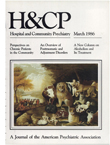Chronic Mental Patients in Nursing Homes: Reexamining Data From the National Nursing Home Survey
Abstract
A reanalysis of data from the 1977 National Nursing Home Survey, including data not available earlier, led to an estimate that 668,000 chronic mentally ill patients reside in nursing homes. Several subpopulations of nursing home residents were also identified and compared, which showed, for instance, that residents with only mental disorders were younger, were less likely to need the help of another person in daily activities, and were much less likely to be totally dependent than residents with only physical disorders. However, not surprisingly, mentally ill residents were more likely to have behavior problems and to have much longer stays. Residents diagnosed as senile, with or without a physical disorder, more closely resembled the purely physically ill than the purely mentally ill patients. The data illustrate the wide range of needs of mentally ill nursing home residents and reinforce the importance of assessing and improving the appropriateness of care offered.
Access content
To read the fulltext, please use one of the options below to sign in or purchase access.- Personal login
- Institutional Login
- Sign in via OpenAthens
- Register for access
-
Please login/register if you wish to pair your device and check access availability.
Not a subscriber?
PsychiatryOnline subscription options offer access to the DSM-5 library, books, journals, CME, and patient resources. This all-in-one virtual library provides psychiatrists and mental health professionals with key resources for diagnosis, treatment, research, and professional development.
Need more help? PsychiatryOnline Customer Service may be reached by emailing [email protected] or by calling 800-368-5777 (in the U.S.) or 703-907-7322 (outside the U.S.).



